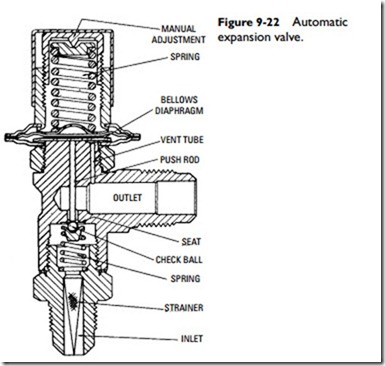Liquid Refrigerant Control Devices
Each refrigeration system may be described in terms of a low side and a high side of operating pressure. The low side is that part of the refrigeration system that normally operates under low pressure (as opposed to the high side). It is identified as that part of a refrigeration system lying between the expansion valve and the intake valve in the compressor, and includes the evaporating or cooling surface, the intake line, and the compressor crankcase—in other words, that part of the refrigeration equipment under intake pressure. The term low side is sometimes used to designate the evaporator coils.
The high side is that part of the refrigeration system operating under high pressure. The term high side is sometimes used to designate the condensing unit.
Some form of expansion device is necessary to control the flow of liquid refrigerant between the low and high sides of a refrigeration system. The following expansion devices are designed to pro- vide automatic control of refrigerant flow:
1. Automatic expansion valves
2. Thermostatic expansion valves
3. Float valves
4. Capillary tubes
Automatic Expansion Valves
An automatic expansion valve is a pressure-actuated diaphragm valve used to maintain a constant pressure in the evaporator of a direct-expansion mechanical refrigeration system (see Figure 9-22). It accomplishes this function by regulating the flow of refrigerant from the liquid line into the evaporator. In this way, the evaporator is always supplied with the proper amount of refrigerant to meet conditions. An automatic expansion valve does not respond well to load fluctuations. For this reason, it is not recommended for use in air-conditioning (see Thermostatic Expansion Valves).
Related posts:
Incoming search terms:
- refrigerant control device
- refrigerant control devices
- REFRIGERANT CONTROL
- term refrigerant control
- air conditioning and refrigeration control devices
- refrigeration system and air conditioning system control devices
- google search refrigerant control
- control devices in refrigeration system
- type of control device in air conditioning
- What are the different type of refrigerent control devices
- what are the control devices in refrigeration and air conditioning and their functions
- what are function of control device in refrigeration and air conditioning
- refrigerant controls
- various refrigeration and air conditionong control and their functions
- State the functions of control devices in refrigeration and air conditioning
- various control devices in refrigeration and air conditioner
- types of refrigerant control devices
- Refrigent control device
- Refriegent control devaice
- refregirant control devicess
- another type of liquid refrigerant control
- autmatic expansion valve
- control device in air-conditioning and Refrigerator
- control devices in air conditioning and refrigeration system
- control devices in refrigeration and air conditioning
- control devices in refrigeration and air conditioning system
- function of flow control device- air condition system
- how many types regrigerant controls
- list 5 refrigeration control devices used in refrigeration and air reconditioning system
- list type of control devices that are used in refrigeration and air conditioning
- mention 5 types of refrigerant flow control device normally used
- mention five types of refrigerant control devices
- Name seven types of refrigerant control devices
- Name two main types of liquid refrigerant controls
- what is refrigerant control device
